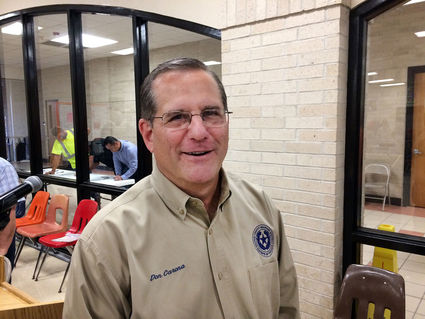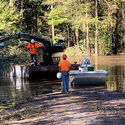Orangefield homeowners seek flooding answers
Last updated 10/22/2019 at Noon
Photo: Don Carona, general manager of the Orange County Drainage District
Dave Rogers
For The Record
Upset Orangefield-area homeowners listened glumly Monday night as Orange County, state and federal officials made it clear there’s no quick fix to flooding.
Then, from one of the 150-plus folks that filled up the Orangefield Middle School auditorium a suggestion came that flies in the face of the frenzy of home building and giddy anticipation of a hoped-for $8 billion plastics plant being built here by Chevron Phillips Chemical:
A moratorium on new building until current drainage problems are remedied.
“This is an emergency,” one man said. “We need to stop overbuilding in these areas close to marshes.
“There has been too much building in our area since Harvey.”
Another homeowner summed it up for many Orange County residents in the wake of Tropical Storms Harvey, which dumped 62 inches of rain in four days in August 2017 and Imelda, which deposited 32 inches of rainfall in 16 hours last month.
She said she had been told it would cost $200,000 to elevate her twice-flooded home, which she couldn’t afford. The alternative was increased flood insurance payments ranging from $9,000 more per year to $24,000 more, according to quotes she had received.
“I love progress. I love growth. But there was no planning for this runoff,” she said. “I blame the city and the county. If you can’t guarantee me you’ll have this fixed in two years, give me the option to have you buy me out.”
Don Carona, general manager of the Orange County Drainage District, who was running the meeting, the third of four set up by OCDD to exchange information with homeowners, identified three major drainage problems for those living along Farm to Market Road 1442:
“This is the new normal,” he said, of the slow-moving storm systems that lift water from the Gulf of Mexico and pour it on Southeast Texas, and building rules have not kept up even with old rainfall totals.
A positive change, Carona explained, is that new housing developments must have a drainage plan OK’d by county and local officials before getting the go-ahead to build.
“But we can’t eliminate all flooding during these historic rains,” the drainage manager said. “Our goal is to limit and reduce significantly flooding during these historic rain events.”
The fourth and last drainage meeting of this series will be held at 6 p.m. Tuesday, Oct. 29, at the Little Cypress-Mauriceville High School Auditorium. It will focus on the eastern portion of Orange County, including the cities of Orange, West Orange and Pinehurst and areas along Adams Bayou and Little Cypress Bayou.
For the folks gathered Monday, those who live roughly in the area inside County Precinct 3, the water comes into the area from the north via Cow Bayou.
“It was Cow Bayou that affected about 70% of Orange County,” Carona said. “Roughly 40% of the Cow Bayou watershed comes from Jasper County above us. We need to divert some of that overflow.”
He said Orange County has since the 1930s had a relief ditch carrying some Cow Bayou water east from just inside the Jasper County line to the Sabine River.
“It’s by far the biggest man-made ditch in the county and it’s already diverting water. But we want it to handle more. There’s so much water from Jasper County,” Carona said.
The Jasper County outflow is the reason water continues to flow into Orangefield neighborhoods after the rains stop, Carona said. But he added the main reason it backs up from the south is a saltwater marsh restoration project undertaken by the Texas Parks & Wildlife Department and the U.S. Corps of Engineers after 2008’s Hurricane Ike, which was a “storm surge” hurricane unlike the major rainfall events in recent years.
Several Orange County drainage district ditches used to extend into the Bessie Heights Marsh that drains much of the west side of the county. But now they dead-end well short of the marsh.
Carona showed Google Earth maps from before and after the marsh restoration, noting the big difference was the importing of 1.6 million cubic yards of silt.
“Has the Parks and Wildlife Department acknowledged their project has caused the problem?” asked one of about two dozen homeowners who stepped up to talk.
“That would be a stretch,” Carona replied. “I do think, though, we have Parks and Wildlife’s attention.”
“What about the Corps of Engineers?” he was asked.
“Not so much,” was the answer.
State Rep. Dade Phelan, one of about 30 paid or elected governmental officials who attended the meeting, said the Corps of Engineers wasn’t known to be easy to deal with.
“That’s the federal government and they’re not very responsive to the state,” Phelan said. “They [the Corps] are considered the fourth branch of government in Washington, D.C.”
The OCDD has 54 employees, an annual budget of $8 million, and maintains 600 miles of ditches. In the last 18 months, it has combined with Orange County’s Roads & Bridge Department to clear and widen drainage channels throughout the Orangefield area.
County Road & Bridge employees maintain 392 miles of roadways, with ditches or drains on both sides. County Engineer Clark Slacum oversees 40 employees in this department, about 10 per precinct.
County Judge John Gothia said cooperation with U.S. Rep. Brian Babin is helping push the removal of an unused railroad spur at the Entergy power plant that has created a barrier to stormwater.
The railroad tracks were at one time considered a national security priority by the Department of Homeland Security and must be de-certified by DHS before removal.
The OCDD began a de-snagging project on Cow Bayou Tuesday, about a mile south of Interstate 10. It’s a project 90% funded by a grant from the Natural Resources Conservation Service.
Workers are removing trees from the water and those leaning over it, loading them on two barges. Ultimately, they will be collected and burned at Riverside, in Orange.

















Reader Comments(0)